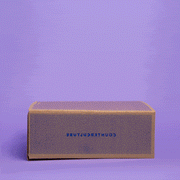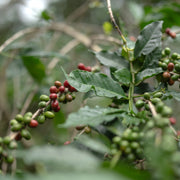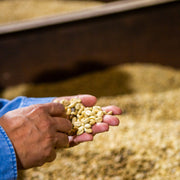Containing more than 900 aromatic compounds, coffee is one of the world’s most complex culinary products. Whether you enjoy floral, citric cups from your V60 or mellow, roasty brews from your French press, you may have wondered how your coffee comes to taste this way.
So, how does coffee get its flavor? There are many factors that impact coffee’s flavor on its journey from crop to cup. In addition to explanations of flavor drivers, we’ve also included some extra details on steps of the value chain that impact the overall quality of your coffee. While these factors might not determine whether your coffee has notes of pineapple or prune, they’re important determinants of the overall excellence of your coffee.
Factors That Impact Coffee Flavor
Plant Type

There are at least 129 species of coffee, with each producing a unique set of flavors. At Counter Culture Coffee, we feature Arabica coffee—the world’s most popular species—because of its cup qualities of complex acidity and low astringency.
Within the Arabica species, there are hundreds of subspecies, known as varieties. With unique physical characteristics and distinct traits in the cup, the variety of a plant can tell you a lot about the anticipated flavor of a coffee.
While variety recognition is largely under-recognized in coffee, the wine industry uses this language frequently. Cabernet sauvignon, syrah, pinot noir, and merlot are all different types of grapes, with known variances in their flavor profiles.
Similarly, coffee drinkers looking for a coffee with notes of stone fruit, toffee, and caramel might want to seek out a Bourbon variety. Looking for a chocolate-forward, nutty cup? Give Typica a try!
Processing Method

After coffee is harvested, the seeds must be removed from the coffee fruit. This removal is commonly known as processing. Most processing methods employ fermentation to help acidify the fruit, making it easier to remove from the coffee seed.
Whether dried in the sun or de-pulped and soaked in water, coffee processing can impact flavor through the effects of fermentation, with different microbes imparting unique flavors into the coffee as they consume the fruit sugars and produce esters.
Different processing methods can also shape enzymatic processes inside the coffee. For example, de-pulping coffee triggers enzymes to consume certain sugars in the fruit, resulting in different, flavorful byproducts than found in a natural-sundried coffee.
As a rule of thumb, natural-sundried coffees tend to taste more fruit-forward and offer juicier bodies, while washed coffees exemplify higher acidity, complexity, and light bodies.
Roasting

Transforming coffee from its raw form, roasting sets off a chain of chemical reactions in coffee. As sugars reduce, acids simultaneously increase and decrease, and the coffee becomes more brittle, hundreds of volatile aromatic compounds come to life inside each coffee seed.
While all roasting follows the same basic principles, each coffee must be approached with a unique profile in order to highlight its inherent characteristics. Whether a roaster decides to use a hot and fast charge versus a slow and steady charge can radically impact the acidity in the cup, while levels of development time will impact how much “roasted” flavor ends up in the coffee.
Roasters draw on variables like plant variety, moisture content, elevation, and processing method in order to determine the best starting point for each roast. At Counter Culture Coffee, our roasting team cups their roasts multiple times a week, noting each coffee’s profile and making adjustments to continuously improve cup quality. This team also coordinates with our coffee-buying department to ensure each roasts complements the innate characteristics of the coffee.
Brewing

The final step in coffee’s global journey determines how the coffee will finally be presented to the drinker. Whether brewing for yourself or making coffee professionally, it’s the responsibility of each brewer to ensure they steward the coffee to the best possible end: a cup that’s appreciated, enjoyed, and savored.
Every cup of coffee can be understood in terms of two measurements: extraction and strength. Extraction relates to the amount of ground coffee dissolved during the brewing process, while strength is understood as the concentration of dissolved coffee in the final cup. Extraction and strength can be controlled by adjusting variables like coffee-to-water ratio, grind size, brew time, water temperature, water quality, and turbulence of water in the brew bed.
Learning to control these variables gives the brewer ultimate control over their cup’s flavor. If you enjoy higher-acidity coffee, you may consider using a relatively coarser grind size, while drinkers who enjoy high-strength brews may want to use a concentrated brewing ratio to achieve a full-bodied cup.
Factors That Impact Coffee Quality
Coffee Plant Health

As with any agricultural product, coffee trees must be diligently maintained. Farmers must ensure irrigation, regular soil fertilization, and pruning occur to guarantee the health of the plant. The healthier the coffee plant itself, the better the coffee it produces will taste!
Elevation and Temperature Fluctuation
The higher the difference between daytime and nighttime temperatures, the more complex a coffee tends to taste. When temperatures dip at night, coffee shifts its energy into fruit and seed production, resulting in a higher density of nutrients. As a result, these coffees tend to be higher quality.
If you’re looking for a quick signifier of coffees that have experienced temperature swings, look for the growing elevation. With all other variables fixed, the higher a coffee is grown, the higher the cup quality.
Harvesting and Sorting Coffee

While specialty coffee is hand-picked, lower-quality coffee productions may employ a method known as strip picking. Using machines that agitate the branches of the plants, strip picking produces a mixture of underripe, ripe, and overripe fruit that results in reduced quality. In order to ensure the highest quality, farmworkers must select only the ripest coffee cherries. This meticulous work must be done manually, with each tree being picked over multiple times during a given harvest. Picking coffee this way is difficult, skilled labor, resulting in superb quality that would not be possible without the fastidious attention to detail of the people harvesting the coffee.
In order to further ensure coffee quality, the fruit may be sorted after harvest. In some operations, pickers will lay the coffee out and remove coffee with insect damage or off-ripe color from the lot, setting it aside to be sold separately as a lower-quality product.
Some producers may opt to “float” the coffee fruit, adding the coffee to a trough of water and skimming off any fruit that float to the surface. This is an efficient way to sort out underdeveloped seeds from the mix, which would produce a lower-quality coffee. As with hand-sorting, these coffees are often separated and sold as a different lot.
Drying and Storing Coffee

Once a coffee has been processed, it must be dried to create a stable product. In specialty coffee, many producers use a moisture meter to dictate this process, aiming to dry their coffee between 8–12%. As a general rule of thumb, coffees with higher moisture contents experience fade faster. At Counter Culture Coffee, we aim to buy coffees with moisture contents no higher than 10.5%, ensuring a longer shelf life for quality green coffee.
Drying may occur on beds of netting, on patios, or in mechanical dryers. In any instance, it’s vital to ensure that the coffee is receiving an equal amount of heat exposure and doesn’t sit for too long; coffee left resting on a patio will dry unevenly, resulting in a degradation of quality.
Once the coffee has achieved its ideal moisture content, it must be packaged for storage and shipment. While many people associate coffee bags with jute, a common practice for high-quality coffee is to use GrainPro, a plastic packaging that acts like a giant Ziploc bag. These bags ensure a stable, dry environment for the coffee, protecting it from exposure to any odors, chemicals, or liquids that could taint the coffee during its journey from origin to roasting.
Coffee Packaging and Roast Dates

Once your coffee is roasted, it’s transitioned into an airtight, UV-proof package, meant to preserve the coffee’s flavor.
During roasting, carbon dioxide builds up inside the coffee as a result of the various chemical reactions taking place inside the bean. Over the following days and weeks, that carbon dioxide will slowly seep out of the coffee, carrying flavorful aromatic compounds with it. While the timeframe varies by coffee, packaging type, and roast level, most coffee will start to exhibit stale flavors after a month.
To slow the release of this carbon dioxide, it’s prudent to store your coffee in a dark, cool, and dry environment. Counter Culture Coffee bags provide such an environment, utilizing a one-way valve to allow carbon dioxide to escape the bag without letting oxygen back into the package. If seeking to further preserve roasted coffee, you can use a vacuum-sealed canister to extend shelf life.
Want to master your brewing skills? Check out our brew guides, learn our quick tips on better brewing at home, and join us for a coffee class at a Training Center near you!







